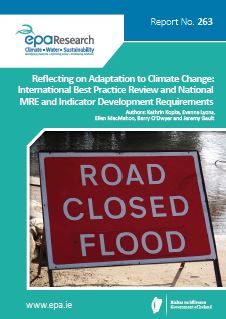Authors: Kathrin Kopke, Evanna Lyons, Ellen MacMahon, Barry O’Dwyer and Jeremy Gault.
Summary: Adaptation Preparedness Indicators for Ireland aims to identify draft adaptation indicator sets. The project carried out a review of international best practice to ascertain criteria and constraints relevant to adaptation indicator development in Ireland.

Preparing human and managed natural systems for the physical impacts of climate change will pose a substantial challenge at sectoral and local levels in Ireland. Vulnerable coastal, fluvial and urban areas must take substantive measures to adapt to an anticipated amplification of climatic extremes, as must key sectors involved in the management, use or distribution of water or natural resources. These challenges provide a clear impetus to develop indicators that can measure adaptation performance, to facilitate the development of robust and resilient adaptation plans and measures.
However, perhaps an even greater impetus to do so is provided by global and European moves toward ever-more rigorous monitoring, evaluation and reporting of adaptation progress.
Member States are at various stages of a process to bring their adaptation processes and reporting procedures into line with those adopted at EU level. Accordingly, adaptation policy in Ireland is moving towards alignment with that advocated at EU level.
Developing Irish indicators that can measure the progress of national adaptation processes is supporting EU and UNFCCC requirements for monitoring, evaluation and reporting. This study introduces a draft monitoring, reporting and evaluation (MRE) framework to develop indicators that can measure progress towards adaptation objectives and draws on best practice and guidance from relevant international bodies and EU Member States to identify a set of criteria to facilitate the development of nationally relevant indicators.
A suite of draft adaptation indicators was developed based on best practice, nested within the proposed MRE framework, linking to international and national adaption objectives and incorporating sector specific climate change vulnerabilities. Draft adaptation indicator development concentrated on local authorities and the agriculture and marine and fisheries sectors, which resulted in the identification of 70 draft adaptation indicators.
An additional 197 indicators are proposed for other sectors of interest, which are housed within a Microsoft Excel document, the “Draft Adaptation Indicators” table. The table outlines adaptation objectives, indicator type, organisations that may hold relevant data, available data and data gaps, how individual indicators relate to the European scoreboard and how indicators can be aggregated for national-level reporting.
https://www.epa.ie/media/epa-2020/publications/research/Research_263_Thumbnail[1].jpg